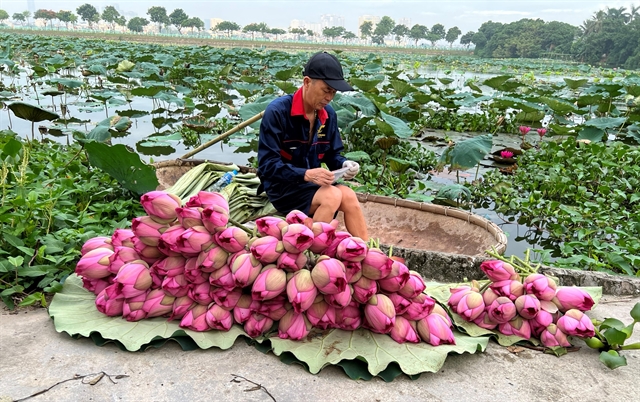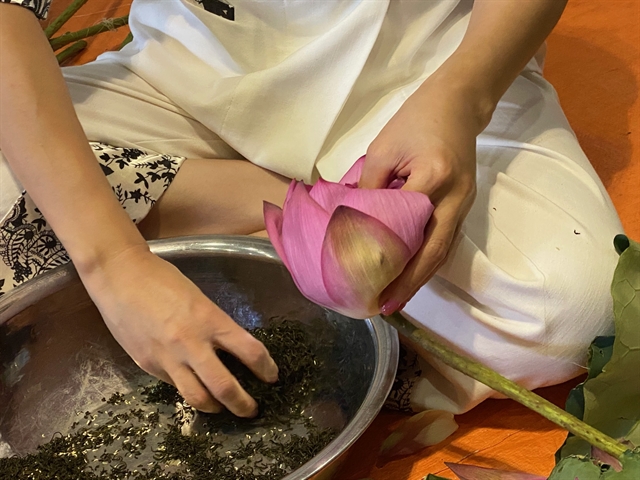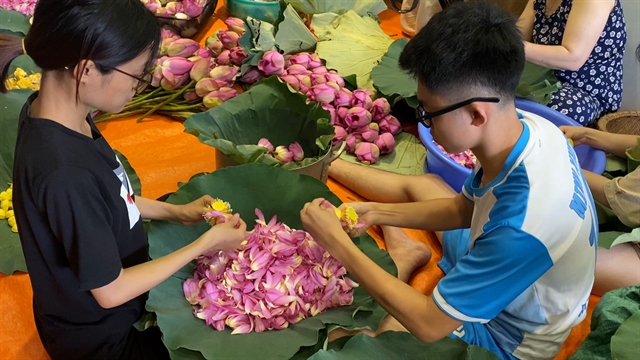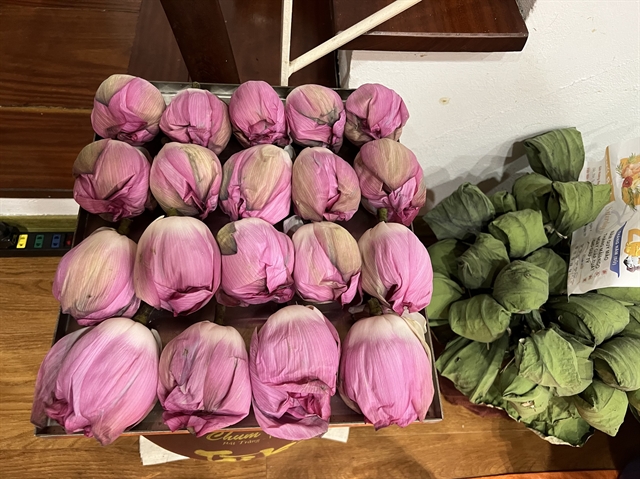By Lê Hương
The lotus is the national flower of Việt Nam thanks to its noble presence and representation of the country's attributes.
Right now in Hà Nội, one can see the immense lotus fields in the West Lake, Trị Pond, and various small lakes in the neighbouring areas.
Lotus in West Lake are famed for their light pink colour and layers of petals with sweeter fragrances than other varieties.
At the end of May, the lotus season starts, and people can see buds of lotus rising from the water. It’s better to admire the lotus pond in the early morning when the summer heat is not strong. Around a lotus pond, one can enjoy cool gusts of wind bringing along a sweet lotus scent. Nothing can be more refreshing.
Lotus season is also a busy time for lotus tea makers around the lake. Lotus flowers should be cut in the early morning, between 5am and 7am.
Lotus tea is a noble drink, containing the essence of nature.
“I think what makes lotus tea popular is the Hà Nội essence in it and also because of the religious meaning of lotus,” tea specialist Nguyễn Việt Bắc told Việt Nam News. “A long time ago, and of course in a different context to now, people would go out in the pond, put tea in half-bloom lotus blossoms in the late afternoon, and then collect them the next morning.
“It’s a simple method but effective. The floral aroma will be very fresh and clean,” he said.
Over time, lotus tea has become a speciality of Hà Nội for guests from afar.

Lotus should be cut early in the morning. Photo Courtesy of Trần Thu Thủy
Trần Thu Thủy lives in the West Lake area and has specialised in making lotus-scented tea for a decade. She often chooses half-bloom lotus flowers to infuse with tea as they have abundant anthers where the pollen is stored and are very aromatic.
The flower is prepared before dried tea leaves are put into the centre of the blossom.
Almost no part of the lotus goes to waste in this process.
At least 1,000 lotus blossoms are needed for 1kg of anthers, the most aromatic part of a lotus flower.

Dried tea leaves mixed with lotus anthers are put inside the lotus bloom. VNS Photo Lê Hương
Thủy often mixes dried tea leaves with lotus anthers and leaves them there for half a day before wrapping the mixture inside a half-blooming lotus and putting it in the drier.
“The tea processor should be clean, and no perfume should be used while making the lotus-scented tea,” Thủy said.
“I really love my homeland and sincerely wish that West Lake Lotus will still be here for years to come,” she said. “Not just to mention the quantity, but in the middle of Hà Nội, we have such flourishing ponds in summer. It’s a beauty of the capital and part of the pride of Việt Nam.”
Trần Minh Quân, a visitor from Thái Nguyên, which grows one of the best tea varieties in the country, admitted that the tea when blended with lotus scent is unforgettable.
“The lotus scent adds a special value to the tea’s flavour,” he said. “A taste that cannot be found in any other herbal drinks. It contains the coolness of summer and the refreshing essence of nature.”

The process uses up all parts of the lotus. VNS Photo Nhật Hồng
Art of drink
Pure fresh water, good tea quality, and a proper tea set are among the most important factors to bring along the best flavour for the tea.
Lotus-scented tea should be made in a traditional baked clay tea set. After cleaning the tea set with boiling water, the tea should be put in with boiling water for around three minutes.
Then the tea should be poured onto cups.

Lotus blooms with tea inside are ready for drying. Photo Courtesy of Trần Thu Thủy
“For real tea drinkers, they want to enjoy the soul of the drink, not just sip it aimlessly,” Thủy said.
“A lot of people like to enjoy the lotus tea with a soothing song in the background. It brings them closer to nature,” she said. VNS
(with an additional interview by Nhật Hồng)

Thủy pours lotus tea into a traditional tea set. VNS Photo Lê Hương
OVietnam